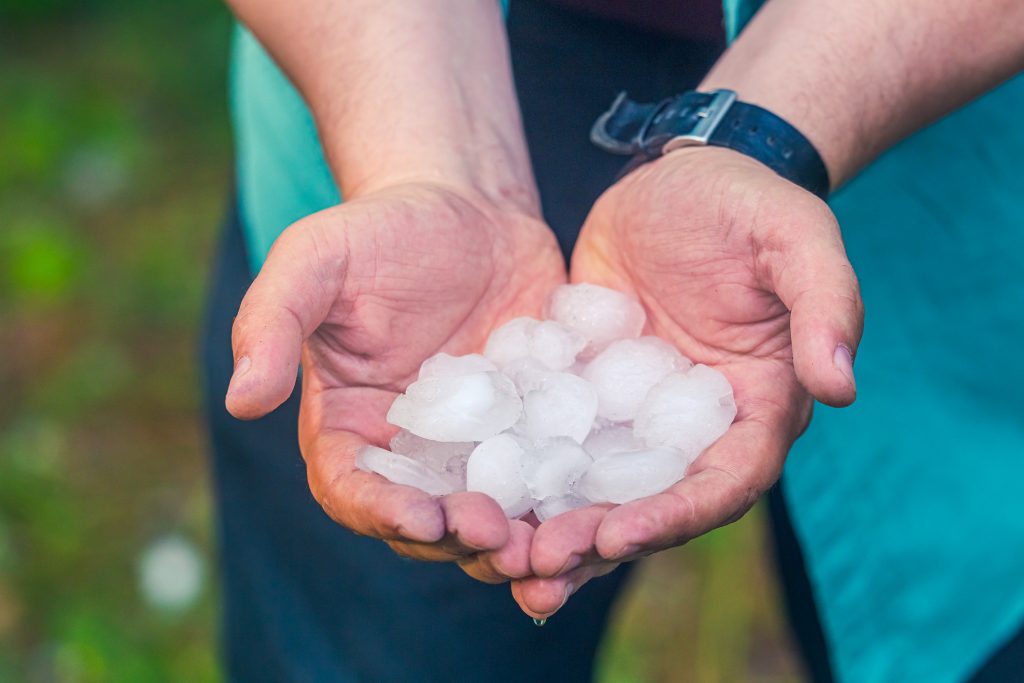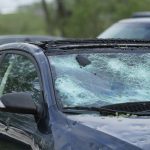You’re sitting at a red light on I-35 when you hear it—that first ping against your windshield. Then another. Within seconds, your car sounds like it’s being pelted with rocks. You pull under an overpass with dozens of other drivers, all of you watching helplessly as golf ball-sized hail bounces off the pavement.
If you’ve lived in the Dallas-Fort Worth area for more than a year or two, this scene probably feels familiar. That’s because it is familiar—almost predictable, even. The DFW region isn’t just unlucky when it comes to hail. We’re living in what meteorologists call the Texas Hail Belt, and our location makes us one of the most hail-prone areas in the entire country.
But why? What is it about North Texas that turns spring and summer afternoons into a game of automotive roulette?
The Perfect Storm: How Hail Actually Forms
Before we get into why DFW is ground zero for hail damage, it helps to understand what’s actually happening up there in those angry-looking clouds.
Hail starts innocently enough. Warm, humid air from the Gulf of Mexico rises into the atmosphere. As it climbs higher, temperatures plummet, and those water droplets freeze into tiny ice pellets. But here’s where things get interesting: in a powerful thunderstorm, updrafts—essentially vertical wind tunnels—catch those ice pellets and throw them back up into the cloud before they can fall.
Each trip up, the pellet collects more moisture and adds another layer of ice, like a frozen jawbreaker. This cycle can repeat multiple times. The stronger the updraft, the longer the hailstone stays aloft, and the bigger it grows. Eventually, gravity wins. When the hailstone becomes too heavy for even the most powerful updraft to hold, it falls—sometimes from heights of 30,000 feet or more.
In supercell thunderstorms, which are exactly as intimidating as they sound, these updrafts can reach speeds of 100+ mph. That’s when you get hail the size of baseballs or even softballs—the kind that doesn’t just dent your hood, but can punch straight through a windshield.
North Texas sees more supercell activity than most places in America. That’s problem number one.
Why DFW? The Geography of Bad Luck
The Hail Belt isn’t random, and DFW didn’t end up in the bullseye by accident. Several geographic and atmospheric factors converge right over our heads:
The Collision Zone
DFW sits at a meteorological crossroads. Warm, moisture-laden air from the Gulf of Mexico flows north and runs headlong into cooler, drier air coming down from the Rockies or the northern plains. When these air masses collide, they create the kind of atmospheric instability that fuels severe thunderstorms. It’s like mixing a cocktail specifically designed to produce hail.
Nothing in the Way
Unlike regions with mountains or significant elevation changes—which can disrupt or weaken storms—North Texas is basically one giant, flat runway for severe weather. The plains and prairies offer zero resistance. Storms can build, organize, and intensify without anything slowing them down.
The Storm Highway
Meteorologists have tracked storm systems across Texas for decades, and patterns emerge. Many systems naturally track along corridors that pass directly over or near the metroplex. We’re not just in hail country—we’re on the highway that hailstorms take to get where they’re going.
Seasonal Sweet Spot
Spring and early summer bring the most volatile conditions. Temperature contrasts are sharpest, moisture is abundant, and the jet stream positioning is just right. March through June? That’s prime time. And DFW sits right in the zone where all these seasonal factors peak at once.
The Numbers Don’t Lie: DFW’s Hail Reality
Residents don’t need data to tell them hail is a problem—they’ve got the dents to prove it. But the statistics paint a sobering picture:
Texas Leads the Nation
According to the Insurance Information Institute, Texas consistently ranks first in the country for hail-related insurance claims. Not second. Not top five. First. Year after year.
DFW at the Epicenter
Within Texas, the metroplex counties—Dallas, Tarrant, Collin, Denton—routinely dominate the claim rankings. These aren’t occasional appearances. They’re permanent fixtures on the list.
Historic Damage Events
Some storms become legendary. In April 2016, a massive hailstorm tore through Central Texas, causing over $1.4 billion in insured losses. While that storm was centered near San Antonio, similar events have hammered the DFW area repeatedly in recent years. The northeast metroplex and the I-35 corridor have seen multiple storms drop baseball-sized hail, overwhelming auto body shops and leaving insurance adjusters working overtime for months.
Here’s what a typical severe hail year looks like in North Texas:
MonthHail Events (Avg)Peak Hail SizeRisk LevelMarch5-8Quarter to Golf BallModerate-HighApril8-12Golf Ball to BaseballVery HighMay10-15Golf Ball to BaseballVery HighJune6-10Quarter to Golf BallHighJuly-Aug3-6Pea to QuarterModerate
The takeaway? If you live here, it’s not a question of if your car will see hail, but when.
Busting the Myths: What People Get Wrong About Hail
Living in the Hail Belt has given rise to some persistent misconceptions. Let’s clear a few up:
“Hail only happens in spring.”
Spring is definitely peak season, but hail can strike any time between March and September. Late summer storms, fueled by afternoon heating, can be just as damaging. I’ve seen parking lots full of dented cars in August.
“Small hail won’t hurt my car.”
Even pea or marble-sized hail can chip paint, crack windshields, and create small dents that compromise your vehicle’s finish. Those tiny dents trap moisture and can lead to rust or paint failure down the road. Don’t dismiss small hail events.
“Only rural areas get hit.”
Urban centers like DFW actually concentrate the damage because there are more vehicles exposed in driveways, parking lots, and on streets. Suburbs and cities can get hit just as hard—or harder—than the countryside.
“Once it’s fixed, I’m good.”
Not if the repair isn’t done right. Poor hail repair can leave underlying damage that resurfaces later, or worse, diminishes your vehicle’s resale value. Quality matters.
Your Action Plan: Before, During, and After the Storm
You can’t stop hail from forming, but you can absolutely protect yourself and your vehicle. Here’s what North Texas drivers should do:
Before Storm Season
- Download a reliable weather alert app (WFAA, NBC5, or a dedicated weather radar app)
- Identify covered parking options near your home and workplace
- Research local hail repair shops now, not after you’re dealing with damage
- Review your auto insurance policy—know your deductible and what’s covered
When Storms Threaten
- Move your vehicle to covered parking if possible—even a carport helps
- If you’re caught driving, find an overpass or parking garage immediately
- Avoid parking under trees (falling branches can cause more damage than hail)
- If you must leave your car exposed, face it toward the storm direction to minimize windshield impact
After the Damage
- Inspect your entire vehicle: roof, hood, trunk, doors, and all glass surfaces
- Take detailed photos from multiple angles—these help with insurance claims
- Get a professional assessment quickly; small damage can worsen over time
- Don’t delay repairs—hail damage caught early is easier and cheaper to fix
What to Look for in a Hail Repair Shop
Not every body shop is equipped to handle hail damage properly. When you’re choosing where to take your vehicle, look for these credentials:
Paintless Dent Repair (PDR) Expertise
PDR is the gold standard for hail repair. It removes dents without disturbing your vehicle’s original factory paint, which preserves both appearance and resale value. Any shop claiming to specialize in hail repair should have certified PDR technicians.
Glass Repair Capabilities
Hail often damages windshields alongside body panels. A full-service hail repair facility should handle both.
Dealership and Fleet Experience
Shops that work with dealerships and large fleet operators have proven they can handle high volumes of vehicles efficiently—a critical factor after major hail events when everyone needs repairs at once.
Local Presence
Fly-by-night operations pop up after big storms and disappear just as quickly. Choose an established local business with a track record in the community.
Insurance Partnership
The best shops work directly with insurance companies, streamlining the claims process and reducing your out-of-pocket hassle.
Why This Matters for Your Vehicle
Living in the Hail Belt means you’re playing a long game with your car’s condition. Each hail event that goes unrepaired adds up. Small dents compound. Paint integrity weakens. Resale value drops.
But here’s the good news: with the right knowledge and the right repair partner, you can keep your vehicle in excellent condition despite the weather North Texas throws at it. Paintless dent repair, when done by skilled technicians, can restore your car to pre-storm condition without repainting—meaning no color mismatches, no blended panels, and no questions from future buyers about previous damage.
Standing Strong in the Storm
The Dallas-Fort Worth region will always be part of the Texas Hail Belt. That’s just geography, and geography doesn’t change. What can change is how prepared you are when the next storm rolls through.
Understanding why we get hit so hard—the collision of air masses, the flat terrain, the storm corridors that pass right over our heads—gives you the foresight to act. And knowing what quality hail repair looks like ensures that when damage does happen, your vehicle comes back stronger.
Spring storms are coming. They always do. But you don’t have to be caught off guard.
Key Takeaways
- DFW sits in the Texas Hail Belt due to colliding air masses from the Gulf and northern plains, flat terrain that allows storms to build unobstructed, and natural storm corridors that repeatedly pass over the metroplex.
- Texas leads the nation in hail-related insurance claims, with DFW counties (Dallas, Tarrant, Collin, Denton) appearing consistently at the top of national damage rankings year after year.
- Hail season peaks from April through June, but storms can occur March through September—small hail can still damage paint and glass, so don’t underestimate any hail event.
- Paintless Dent Repair (PDR) is the gold standard for hail damage because it preserves your vehicle’s original factory paint, maintaining resale value and appearance without color mismatches or blended panels.
- Preparation is key: download weather apps, identify covered parking locations now, research qualified local repair shops before damage occurs, and document any damage thoroughly with photos from multiple angles for insurance claims.
If your vehicle has hail damage, or if you’re just trying to stay ahead of the next storm, talk to a professional hail repair specialist who understands the unique challenges of living in the Hail Belt. Your car—and your peace of mind—will thank you.
The next time you hear that first ping on your windshield, you’ll know exactly what’s happening up in those clouds, why it’s happening here, and what to do about it. That’s the power of being prepared in hail country.



